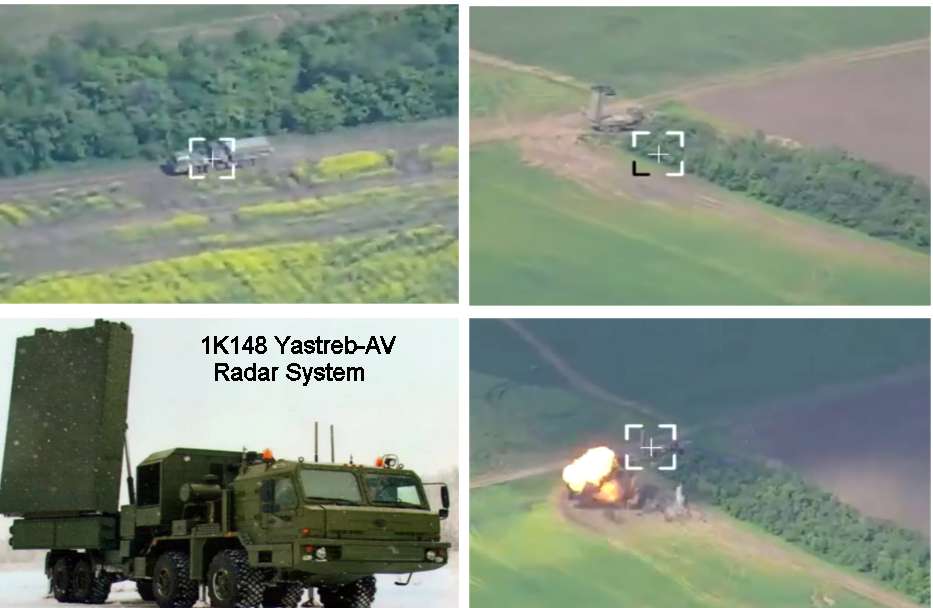- Army
- Conflicts in the world
- Israel - Iran conflict 2025
- Pakistan - India Conflict 2025
- Russia Ukraine War 2022
- Libya conflict day by day
- HAMAS - Israel War 2023
- Operation Serval in Mali French Army
- Sangaris operation Central African Republic
- Sangaris opération militaire République Centreafrique
- Ukraine - Russia conflict
- Syria conflict news
- Defence & Security Industry Technology
- Armies in the world
- Analysis Defense and Security Industry
- Conflicts in the world
- Navy
- Air
Ukraine releases Video Showing First Destruction of Russia's High-Tech 1K148 Yastreb-AV Radar
On April 14, 2024, the X account on @external shared a video published by the former coordinator of the drone training program for the "Return Alive" foundation. This video, dating from May 2023, depicts the first defeat of the Russian Yastreb-AV radar in the Donetsk region.
Follow Army Recognition on Google News at this link

Russia's high-tech 1K148 Yastreb-AV radar system destroyed by Ukrainian Defense Forces (Picture source: Ukraine Social Media)
The footage shows that the American M142 HIMARS rocket launcher was used to overcome the Russian defense forces' complex. GMLRS rockets hit the Yastreb-AV artillery reconnaissance complex nearby, likely causing damage.
The "external pilot" stated that the strikes on the complex were adjusted using the Shark reconnaissance drone from the 43rd separate artillery brigade, which was monitoring Russian movements. According to him, this is the first Shark drone delivered to the military as part of the joint project between the "Return Alive" fund and the OKKO gas station network, named "Eye for an Eye." It appears that the Yastreb-AV counter-battery radar was detected and struck near the city of Enakieve.
The Shark UAS includes a communication range of up to 80 km, a maximum ceiling of 3,000 m, an operational altitude of 1,000 m, a flight time of 3 hours and 30 minutes, and a cruising speed of 75 km/h. The Shark UAS can be catapult-launched and is equipped with a capable camera system with an optical zoom of up to 30x, a total zoom of 90x, and a maximum tracking distance of up to 5 km, incorporating digital stabilization and anti-fog features.
The Army Recognition editorial team explained on January 3, 2024, the destruction of a second Russian 1K148 "Yastreb-AV" artillery reconnaissance complex in the Donetsk region. Following the use of the HIMARS MLRS, the enemy's counter-battery radar was disabled and engaged.
The specifications of the 1K148 Yastreb-AV artillery reconnaissance complex have not yet been disclosed, with tests having been completed at the end of 2021 or the beginning of 2022. It was first presented at the international Army-2022 forum. This radar complex, equipped with a phased array antenna, can automatically track the trajectory of shells fired by enemy artillery, thus determining the exact coordinates of their positions.
This high-tech system was specially designed to automatically detect rocket launches, missile strikes, and artillery fire. With its rapid data processing capability, this system would allow for an immediate response by targeting enemy offensive systems.
However, according to Russian sources, the Yastreb-AV counter-battery radar represents an important evolution in Russian artillery detection capabilities, offering remarkable performance and features. With an extended detection range of up to 40 km, the Yastreb-AV stands out distinctly from current systems, including the Russian "Zoo" radar with its 23 km range, and the Western Firedinder "FayaFanda" system, limited to 24 km. Its precision in coordinate determination is also impressive, with a deviation reduced to just 5 to 10 meters, compared to the 20 to 30 meters of current systems. This improvement marks a considerable advance over the current accuracy of the Zoo, which is 30 to 40 meters. The likely use of an Active Phased Array Radar (AFAR) in the Yastreb-AV contributes to this significant increase in accuracy and detection range.
Mounted on an 8x8 BAZ-6910 chassis, the 1K148E Yastreb-AV is shrouded in mystery in terms of its technical specifications. Nevertheless, sources estimate the loss to Russia at $250 million (approximately €228.2 million), marking a significant financial and strategic setback for the Russian military.
The rapid destruction of this counter-battery radar system highlights the vulnerability of Russian military equipment to Western weapons supplied by NATO to Ukrainian forces. This event sheds light on the effectiveness of Ukraine's reconnaissance and precision strike strategies and the challenges Russia faces in managing its advanced equipment on the battlefield.


























